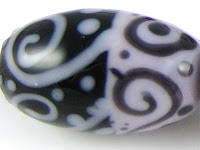1 - Plain, 2 - Plain (reduced), 3 - w/ Silver Leaf, 4 - w/ Silver Leaf (reduced & encased), 5 - w/ TerraNova2 Frit, 6 - w/ Silver Glass Frit (reduced), 7 - w/ Tuxedo, 8 - w/ Copper Green, 9 - w/ Opal Yellow, 10 - w/ Ivory, 11 - w/ White
Do these test beads remind you of anything? If not, they should, because at first glance, they are very, very similar to the test results I got with Faded Rose that were posted a short while back. However, there are some key differences, which I will point out as we go here.
With unencased silver leaf added to the surface of an Orchid bead, the result is an interesting mottled colour that ranges from orange to green in the surface colour. The silver itself wisps up on top of the Orchid. When this reaction is reduced and then encased, the Orchid re-pinks and the silver presents as a snowy, cloudy layer with lavender clouds on its edges.
I had moderate success with my TerraNova2 frit with this colour, and the reducing silver glass frit blend that I used looks pretty darned interesting on top of Orchid. With TerraNova2, the base of my Orchid bead stayed pink, but with the reducing silver glass, my Orchid turned orangey-yellow. These results are similar to what I experienced with Faded Rose.
There is no reaction to speak of between Orchid and Tuxedo (note there is no silvery line when using Orchid on Tuxedo) but on top of Orchid, Tuxedo thins out a little and looks more translucent than I'm used to seeing it. Again, these results are similar to what I experienced with Faded Rose, except for the translucency of the Tuxedo, which has only happened on top of Orchid.
The relationship between Orchid and Copper Green seems kind've complicated. Where I used Copper Green over Orchid, it seems to have empinkened the Orchid quite a lot, and has created a very, very faint transparent film which emanates from the Copper Green. In the centre of the bead where the two colours meet, there is an odd ivory patch that looks like all of the colour has been sucked out of the Copper Green. And then where the Orchid is over the Copper Green, the Copper Green seems really conflicted, ranging from a patina-coated army green to a raging turquoise. This is worth experimenting with, since it'd be nice to know the reason for so much variation. Here is where the Faded Rose and Orchid test results start to differ, since this is not the same reaction I got with Faded Rose and Copper Green at all.
Opal Yellow, like Copper Green, makes Orchid look pinker. On top of Opal Yellow, Orchid looks like a pretty dusty rose colour, but under Opal Yellow, it looks more bubblegummy. On top of Orchid, Opal Yellow lines look like they have a subtle, faintly darker line around them. Faded Rose did not behave this way with Opal Yellow at all -- in fact, the results here are so different, I will need to invent completely separate mental categories for these two Milky Way colours.
Ivory on top of Orchid goes sort of wonky, spreading a bit and developing a transparent, crack-like line in the middle of dots and stringer lines. On the Ivory side of the bead here, the Ivory has curdled and formed what almost looks like a translucent crack around the bead. The Orchid is not very visible on top of Ivory. Faded Rose did not do this with Ivory, so if you are looking for this reaction, it's Orchid you'll want.
The reaction between White and Orchid is quite similar to the reaction between Ivory and Orchid, only it's more subtle. The transparent, crack-like lines/dots in the stringer work are less pronounced, and there is no evidence of curdling on the left-hand side of the bead.
Here is a fun bead made with Orchid. I used a lot of Orchid in twisties as well, and as the base colour for a couple of bicones. Sadly, I can no longer remember exactly which twisties or bicones, so all we are left with is this bead.








No comments:
Post a Comment